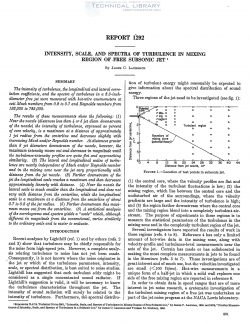naca-report-1292
- Version
- 162 Downloads
- 2.13 MB File Size
- 1 File Count
- November 2, 2016 Create Date
- November 2, 2016 Last Updated
National Advisory Committee for Aeronautics, Report - Intensity, Scale, and Spectra of Turbulence in Mixing Region of Free Subsonic Jet

The intensity of turbulence, the longitudinal and lateral corre-
lation coefficients, and the spectra of turbulence in a 3.5-inch-
diameter free jet were measured with hot-wire anemometers at
exit Mach numbers from 0.2 to 0.7 and Reynolds numbers from
192,000 to 725,000.
The results of these measurements show the following: (1)
Near the nozzle (distances less than 4 or 5 jet diam downstream
of the nozzle) the intensity of turbulence, expressed as percent
of core velocity, is a maximum at a distance of approximately
1 jet radius from the center line and decreases slightly with
increasing Mach and/or Reynolds number. At distances greater
than 8 get diameters downstream of the nozzle, however, the
maximum intensity moves out and decreases in magnitude until
the turbulence-intensity profiles are quite flat and approaching
similarity. (2) The lateral and longitudinal scales of turbulence are nearly independent of Mach and/or Reynolds number
and in the mixing zone near the jet vary proportionally with
distance from the jet nozzle. (8) Farther downstream of the
jet the longitudinal scale reaches a maximum and then decreases
approximately linearly with distance. (4) Near the nozzle the
lateral scale is much smaller than the longitudinal and does not
vary with distance from the center line, while the longitudinal
scale is a maximum at a distance from the center line of about
0.7 to 0.8 of the jet radius. (5) Farther downstream this maxi-
mum moves out from the center line. (6) A statistical analysis
of the correlations and spectra yields a “scale” which, although
different in magnitude from the conventional, varies similarly
to the ordinary scale and is easier to evaluate.
Recent analyses show that turbulence may be chiefly responsible for
the noise from high-speed jets. However, a complete analysis relating turbulence to noise has not yet been made.
Consequently, it is not known where the noise originates in
the jet or which of the turbulence parameters, intensity,
scale, or spectral distribution, is best suited to noise studies.
Lighthill has suggested that each turbulent eddy might be
considered as a single concentrated sound radiator. If
Lighthill’s suggestion is valid, it will be necessary to know
the turbulence characteristics throughout the jet. The
intensity of sound radiation Will surely be related to the
intensity of turbulence. Furthermore, the spectral distribution of turbulent energy might reasonably be expected to
give information about the spectral distribution of sound
energy.
| File | Action |
|---|---|
| naca-report-1292 Intensity, Scale, and Spectra of Turbulence in Mixing Region of Free Subsonic Jet.pdf | Download |

Comment On This Post